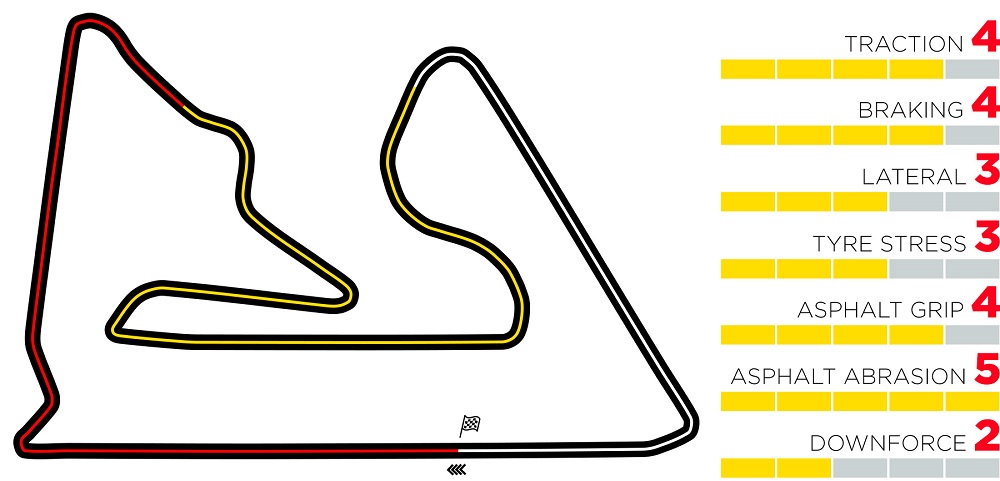COMPOUNDS IN THE MIDDLE OF THE RANGE FOR THE SEASON-OPENER
Dubai, UAE-:
WHY WE’VE CHOSEN THE TYRES
The three middle compounds from the 2021 tyre range have been chosen for this year’s season-opener in Bahrain on some of the most abrasive asphalt of the season: C2 as the P Zero White hard, C3 as the P Zero Yellow medium, and C4 as the P Zero Red soft. This is the same nomination as last year’s Bahrain Grand Prix four months ago, but there is a new tyre construction this year for the latest cars. The 2021 cars in fact have reduced downforce compared to last year, under the most recent technical rules.
At the recent three-day pre-season test in Bahrain, teams had the entire P Zero range at their disposal, but many chose to concentrate on the three compounds nominated this weekend. With the track having been used so recently, little about it will have changed since the teams were last there: giving them a stable basis to work from.
The new tyres for 2021 have been designed to improve strength and durability, allowing them to run at lower pressures, while the actual compounds are the same as last year. During testing of the 2021 tyres last November in Bahrain, rear tyre pressure was reduced by 0.5 psi and front tyre pressure by 1.5 psi. Then, following telemetry analysis and the reduction of rear downforce in particular, rear tyre pressure was further reduced by 1.5 psi at recent test in Bahrain. This is now confirmed for the race.
The number of sets allowed per weekend is the same as last year (13) despite the there being an hour less of running, with Friday’s free practice sessions now cut to one hour each.
As was the case last year, there’s a standard allocation for every car in 2021: two sets of hards, three sets of mediums, and eight sets of softs. The nominations for every race this year have been revealed in advance.
TRACK CHARACTERISTICS
The Bahrain Grand Prix gets underway in the evening at 18:00 local time after sunset and is run under floodlights, with track temperatures that can fall quite rapidly once the race gets underway. This in turn affects tyre behaviour and therefore strategy.
The asphalt (with high granite content) in Bahrain is well-known for being abrasive, increasing tyre wear and degradation. Last year’s race – which featured a red flag and multiple safety car periods – was won by Mercedes driver Lewis Hamilton with a two-stop strategy: medium-medium-hard. Red Bull’s Max Verstappen, who finished second, was one of just two drivers to change tyres four times.
Sakhir is all about traction and braking rather than big lateral loads. All in all, it’s classified as a medium-severity circuit in terms of demands placed on the cars.
FORMULA 2: WHAT TO EXPECT
The Formula 2 season begins in Bahrain and pioneers a new race format, with three races run during a weekend for the first time. The first 23-lap race takes place at 13:25 on Saturday, following free practice and qualifying on Friday afternoon. The second 23-lap race takes place at 19:40 on Saturday underneath the floodlights, while the Sunday’s 32-lap main race takes place at 13:50. The 18-inch tyres that have been nominated are the P Zero White hard and P Zero Red soft: well-suited to the changing conditions expected in Formula 2, with races held both during the heat of the day and after dark. This nomination is different to last year, where the hard and the medium was chosen for this track, now adding an extra tactical variable at the start of this radical new season. The hard F2 tyre (along with the medium) is different in 2021. The new hard tyre for F2 this season reduces wear and graining without losing performance compared to last year. Drivers also have an extra set of tyres (six sets as opposed to five last year) so the whole strategic approach over three races is a clean sheet of paper.
| MIN. STARTING PRESSURES (slicks) | EOS CAMBER LIMIT | ||
| 21.0 psi (front) | 19.0 psi (rear) | -3.50° (front) | -2.00° (rear) | ||
MARIO ISOLA – HEAD OF F1 AND CAR RACING
“Just four months after having two races in Bahrain, and two weeks after three days of pre-season testing, we’re back there for the first race of the 2021 season. During the test we saw many teams concentrated on the compounds nominated for the grand prix, but the conditions we experienced in testing might not be entirely representative of the race. The teams also ran a very wide variety of different programmes during just the one condensed session, whereas in the past, with two test sessions, the second session was usually more focussed on tyres. So it’s hard to draw many firm conclusions. With new specifications of cars and tyres, as well as the shortest pre-season in recent memory, the competition is wide open: especially given that the track characteristics of Bahrain have often resulted in interesting strategic battles, with a number of different tactics used”.

